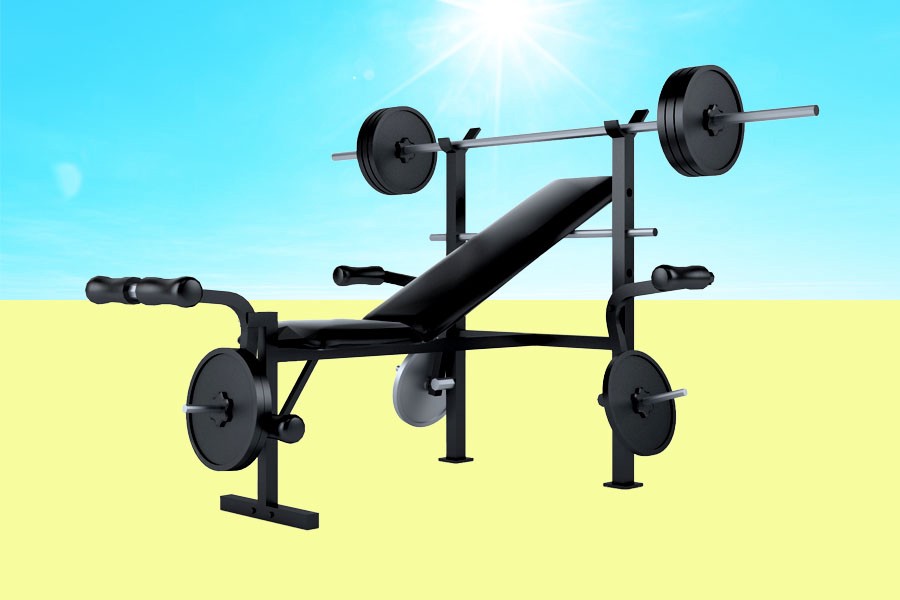According to a recent report published by the Centers for Disease Control, federal guidelines recommend that we log at least 150 minutes of exercise per week. However, just 23 percent of U.S. adults are consistently meeting the guidelines.
In the voice of Mr. Strickland in Back to the Future: SLACKERS! [Out-of-shape editor’s note: Joel is an insanely buff and enthusiastic gym dude, but he means you no harm.]
But don’t worry, oh ye of little fitness motivation, I understand. With busy work schedules, afterwork happy hours and the everyday demands of life just getting in the way, it’s not always easy to make it to the gym, much less summon the motivation to drag your ass over there in the first place.
That’s why I’m suggesting an all-natural alternative: Take your workout outdoors. Your local park, the track at a nearby school or even your backyard can suffice if you’ve got a decent pair of dumbbells. It’s already the fourth quarter of summer, so mornings and evenings are cooling down perfectly to get your workouts in, meaning you’ll be jacked just in time for Halloween to flex your muscles in that body-paint-and-a-thong Silver Surfer costume you’ve been dying to wear.
Here, I’m going to run down the pros and cons of getting your fitness on with Mother Nature.
The Pros
You Save Money! Equinox: Upwards of $175 per month. Gold’s Gym: $150 to join and $30 per month. Even the most inexpensive gyms like the YMCA ($582 per year) and Planet Fitness ($250 per year) can be expensive if you’re strapped for cash. Mess around and miss a few days here and there, and that monthly membership fee turns into a monthly donation. But working out outdoors for free? Priceless.
You Produce More Vitamin D! Some foods in our diet (like tuna, milk and eggs) supply our bodies with vitamin D. But according to researchers, direct exposure to sunlight helps your skin synthesize vitamin D faster and more efficiently. Approximately five to 30 minutes of sun exposure between 10 a.m. and 3 p.m. at least twice a week can produce sufficient vitamin D synthesis. Vitamin D is also essential to the absorption of calcium, which leads to strong bones. It can even stave off various cancers as well as some forms of depression. Just remember to wear sunscreen.
It Can Turbocharge Your Mood! Working out in the sun doesn’t just help your body produce essential vitamins, it also helps boost your mood. A study of 800 adults showed increased feelings of revitalization and energy with decreases in tension and anger after outdoor workouts vs. doing so indoors. The study also reported that participants declared a strong intent to workout outdoors again.
The Cons
The Weather Hazards. Extreme heat, cold and precipitation can derail your outdoor workout in obvious ways, so always consider the weather and dress accordingly. Heat exhaustion can occur when your body reaches 104 degrees, and heat stroke can set in above that temperature. Also, you can be at risk of frostbite and hypothermia if the temperatures run too cold.
The Equipment Restrictions. Working out outdoors may be revitalizing, but you’re not going to find treadmills or ellipticals at your local park. Instead, use nature’s natural resources to your advantage: running down the road or on a scenic trail can be much more rewarding than running in place.
Now, that last point is probably the biggest for most people. You’ve got your gym routine down: How are you going to replicate it at the local dog park? Fact is, it’s not so hard: Much of the equipment at your local gym can be substituted in most outdoor settings just by using your own body weight. In place of the bench press and iso-lateral machines, drop down and do four to five sets of 20 push-ups: You’ll work your pecs nicely as well as pump up your arms, shoulders, back and core.
If you have access to an upright bar — say, the monkey bars in the park — pull-ups are the best alternative to the lat pulldown machine for your back. The bar allows you to diversely work other muscles, too, like your biceps and trapezius, according to your overhand or underhand grip. Use an overhand close grip to blast your traps; go underhand with a wider grip to work your biceps. Also, a pair of parallel bars — which you can find in many parks now — are perfect for your chest and arms: Jump in and do a few sets of dips to give your pecs and triceps a great burn.
You don’t have to skip leg day just because you don’t have a squat or leg press machine, either — walking lunges and jump squats are just as effective to work your hamstrings and quadriceps, and require no equipment.
In summary: While the gym can supply your workout with bells-and-whistles amenities like endless equipment, group fitness classes, steam rooms and saunas (and naked stuff), the great outdoors is the perfect place to supplement your workout and let nature stimulate some feel-good serotonin as well.
Now go outside and get some before summer’s fourth quarter hits the two-minute warning!

